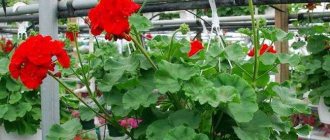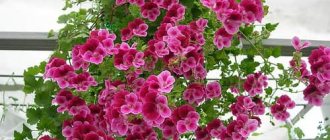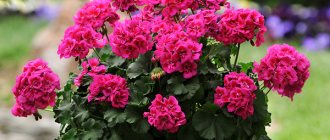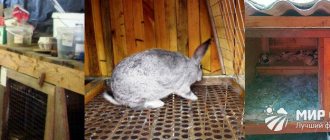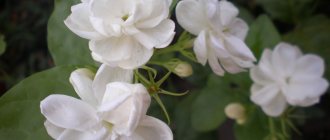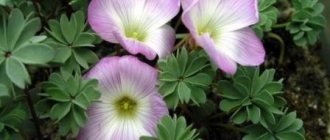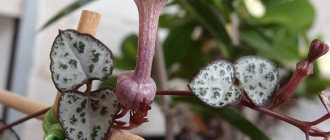Pelargonium is a herbaceous, perennial, semi-shrub plant. There is a more well-known name for this plant - geranium. And very often there is a stereotype that this is a houseplant that grows only in pots on the windowsill. And the appearance is simple red or pink flowers, collected in spherical inflorescences. But this is a very big misconception. The varieties bred today are so diverse and modified in appearance that it is sometimes very difficult to recognize them as the geranium we all know.
Below are varieties with descriptions and characteristics. All pelargonium cuttings are well rooted and adapted. You can buy rooted cuttings of pelargonium by calling or writing in advance by email.
Price from 400 rubles.
Pelargonium rosebud - botanical description and classification
Pelargonium came to Europe from Africa thanks to travelers and colonialists. According to the description, it belongs to the Geraniaceae family. Various plant varieties are adapted for growing indoors and in open ground.
Pelargonium rosebud
Due to the diversity of flower varieties, as well as the many hybrid varieties, today there is no clear classification. The most common types of pelargonium are:
- zonal;
- ivy-leaved or ampelous;
- royal;
- angels;
- unique;
- fragrant.
Geranium rosebud, otherwise called Rosaceae, arose due to an accidental mutation in the 18th century. Subsequent breeding work was carried out purposefully, as a result of which a huge variety of varieties of rose-shaped pelargoniums were bred.
Pelargonium (geranium) - photo
Do you have any doubts about getting seedlings? Then look at these photos too. We have collected the brightest and most beautiful pelargoniums in our selection!
Varieties of indoor plants
How to care for ampelous geraniums at home
Geranium varieties are distinguished by their lush flowering and a wide palette of colors. Not only flowers, but also leaf blades of some varieties can have a decorative appearance.
A huge number of rosebund pelargoniums have been bred
- Rose of Amsterdam
"Rose of Amsterdam" is one of the miniature, fast-growing varieties. Terry inflorescences are painted in white and pink shades. As the plant ages, the buds become more and more vibrant.
- Supreme
"Rosebud Supreme" is distinguished by rich crimson, densely double flowers with white undersides of the petals. Under proper conditions, flowering can continue year-round.
For reference! Supreme typically enters the flowering season later than similar varieties.
- Apple Blossom
"Apple Blossom Rosebud" is one of the oldest varieties of pelargonium. It has, as the name suggests, a delicate apple green coloration with a rich pink edging.
The variety is quite whimsical and requires shading, frequent fertilization and pruning.
- Vectis
“Vectis Rosebud” is a miniature zonal variety with large wine-red buds and a light underside of the petals. Lush, disheveled inflorescences last a long time. The leaves are dark green.
- Red pelargonium "Rosebud Red"
Pelargonium Rosebud Red with deep red flowers. The inflorescences are densely packed and form almost continuously throughout the year. Does not require molding.
- Beverly park
Pelargonium with double, apricot-colored buds with a lighter, almost white edging. The leaf blades are green, darkening towards the central part.
For reference! Beverly Park - suitable for those who prefer a non-standard red color scheme.
- Princess Mary
Compact early flowering variety. The leaves are uniform green. The inflorescences are dense, greenish-white. As they fade, the petals turn pink.
- Rushmoor Golden Rosebud
Rushmoor Gold features bright pink flowers that are not too densely packed. The leaf blades are light, golden-green in color.
Description
Pelargonium rosebud is often called geranium by gardeners. These are really plants from the same family, although they do not resemble each other either in leaves or the main decorative part.
Wild geranium can be seen in the forest. It attracts attention with its modest blue flowers. There are also special varieties for the garden with flowers ranging from white to almost black (through the red spectrum). The plant is resistant to cold.
Pelargonium is a resident of the southern regions. In Russia, it often lives indoors. Only in the summer they decorate balconies and verandas.
And even if they are planted in the ground, by the end of the warm season they are returned under the roof.
Blooms with beautiful umbrellas. You can find a green beauty with white, pink or deep red buds. It does not have blue flowers. The bush reaches a height of 80 centimeters.
The similarity between pelargonium and geranium is that they have almost identical seed pods.
Pelargonium rosebud appeared in the 19th century in Europe thanks to a mutation. The fashion for growing such wonderful roses originated in England. They were used to make bouquets. At the same time, amazing bushes were brought to Russia.
There are about 250 species of pelargonium. They are divided:
- for hanging ones - with flexible stems that beautifully hang down or curl over surfaces;
Read also: Idaho potatoes in a slow cooker
- zonal - straight bushes with dense foliage and small flowers;
- dwarf - small-sized plants, most suitable for use in the home;
- ivy hybrids that combine the properties of all three varieties.
Among the most striking and popular varieties are the following.
- Vectis Rosebud. A miniature shrub with clusters of small bright red roses. It blooms luxuriantly for several months. Allows you to easily form a crown.
- Pink rambler. A strong-looking bush with corrugated leaves and rich pink flowers. The petals are beautifully shaped, lighter on the inside. Easy to care for, throughout the warm season it pleases with the beauty of its buds.
- Monseruds Rosen. Blooms with red flowers with a purple tint. Because of this color, the buds give the impression of being heavy and rich in appearance. There are also Monseruds Rosen with white specks on the petals. This variety is not easy to grow because it produces many side shoots. Crown formation requires constant attention.
- Apple Blossom. It is a perennial bush, on the tops of which beautiful dense umbrellas of double white flowers with a pink border grow. The bush is growing quickly. It needs to be constantly trimmed. If this is not done, the shoots begin to stretch greatly, losing foliage. Because of this, the plant loses its attractiveness.
- Supreme. It blooms late with lush red bouquets of small roses. The bush is not difficult to care for and can easily be formed into a crown.
- Millfield Rose. Hybrid pelargonium with large pink buds collected in dense inflorescences. It is often used for landscaping because it tolerates temperature changes well. It begins to bloom in the second year of life.
- Unicorn Zonartic Rose . It is a bush of compact size with large - up to 8 cm - double flowers of pink-red color. The variety is unpretentious, the bushes provide lush flowering.
- Jubilee Rose. The rich purple or fuchsia petals have a texture reminiscent of corrugated paper with wavy edges. This pelargonium pleases with colorful voluminous caps of lush flowers. The plant itself looks like a strong bush with leaves close to each other.
- Ice Rose. A bush of rich green color with shiny thick leaves. It grows slowly. White roses reach 6 centimeters in size.
- Grainger's Antique Rose. A plant with rounded leaves characteristic of pelargonium. It blooms with unusually large roses with a silky texture, collected in beautiful caps.
- Brookside Rosa. An unusual miniature bush of a zonal type. It has bright leaves and rich pink petals. It grows quickly and bushes. Therefore, it is necessary to trim the elongated shoots in time.
- "Australian Pink Rosebud." A hybrid that appeared in Australia through the efforts of local breeders. The plant resembles a real bush rose and requires gentle handling. It has pink buds of the correct shape, as if they had not fully opened. Leaves of rich green color serve as an excellent frame for the roses themselves, collected in large inflorescences.
The bush looks strong, with a large number of side shoots.
- Marbacka Rose. The plant stretches quickly as it grows, does not need pruning and does not require special efforts to maintain it in a healthy state. The fluffy flowers, collected in large clusters, have pink buds of a delicate shade, and also have a tone close to the skin tone. This pelargonium blooms almost continuously and takes root easily.
- "Night Rose". It is a bush about 30 centimeters in height. Leaves are brown. The pink-violet buds are collected in large spherical inflorescences. If pelargonium is properly cared for, it will delight you with flowering all year round.
- "Millfield Rose" It is a bush with voluminous and heavy-looking pale pink buds, similar to real roses. The stems of the plant are branched and have many leaves. This variety is in great demand among gardeners.
- Bornholm. A massive bush with bright red terry, as if satin, buds, collected in beautiful brushes. The petals open slowly and not completely. But the flowers that appear delight with their appearance for quite a long time. The plant requires close attention, because if it grows too much, it will not be able to bloom.
- PAC Viva Carolina. Very beautiful pelargonium with large pink buds. Some hybrids have transitions in the shades of the petals - lighter in the middle than along the edge. Flowering lasts a long time and is lush. From a distance the flowers look like real roses.
- Denise. A well-known variety, the representatives of which show the world two-colored, not fully open buds - the white color in them gradually turns into bright pink. A lot of buds appear. They are collected in neat bouquets. The bush is not particularly tall, but strong.
- Queen Ingrid. It is a tall bush with large, dense balls of double flowers in many shades of pink and cream. The plant provides abundant flowering.
- Anita. The bush reaches half a meter in height. The leaves have a light shade and texture with a slight corrugated effect. Flowers delight with balls of dense pink buds. These flowers do not open fully, reminiscent of classic garden roses. The variety does not require much effort in processing. Frequent pruning is not required.
- Achievement. The buds of this pelargonium are soft and silky to the touch. They have a pleasant shine. They consist of many petals, slightly curved along the edge, opening strongly as they bloom.
Caring for rosebud pelargonium at home
Varieties of geraniums - what lemon and field geraniums look like
Rose geranium requires special treatment; it should be cared for by following certain rules. By adhering to them, you can achieve long-lasting lush flowering.
Watering should be regular and moderate
Illumination and temperature conditions
Pelargonium rosebud tolerates bright sunlight and partial shade. On a personal plot, it can be planted on an alpine hill, placed in a hanging flowerpot, or placed in a flowerpot in the shade of trees.
Note! When there is a lack of lighting, geranium foliage becomes lighter and may fall off, the stems become elongated, and flowering is delayed or does not occur at all.
The flower does not tolerate heat very well. Maximum permissible temperature 28 °C. Otherwise, the plant will become lethargic, and the flowers will fall off earlier than expected.
Watering rules and humidity
Pelargonium bushes should be watered sparingly. The flower tolerates drought much easier than excessive moisture and stagnation of water.
The plant almost does not react to a decrease in the level of air humidity in the room. In rare cases, the edges of the leaves may dry out.
It is not advisable to spray pelargonium. The accumulation of moisture on fuzzy leaves can cause them to rot. You can humidify the air using a tray with pebbles and water.
Fertilizing and soil quality
Soil for rosebud geranium when caring at home can be purchased in specialized stores or mixed with your own hands. Taking a universal soil mixture, you can add perlite and sand to it to achieve better air permeability.
Self-preparation of soil involves the following proportions of components:
- peat - 2 parts;
- turf soil - 4 parts;
- river sand and perlite - 1 part each;
- humus - 2 parts.
It is recommended to feed the flower from the end of February. The application of nitrogen-containing fertilizers will allow the bush to gain green mass. Closer to the onset of the flowering period, they begin to add potassium and phosphorus to the fertilizing.
Rosebud pelargonium requires feeding
Flower container size
Flowerpots for rose-shaped geraniums are selected to be small, made of unglazed ceramics. The soil in such a container will dry out better and the roots will receive enough air.
Pruning and replanting
Rosebud pelargonium is pruned twice a year. In autumn, old shoots that have shed their leaves are cut off, and elongated stems are shortened by at least a third. In spring, only gentle pinching is done, otherwise the plant may not bloom on time.
Replanting is carried out as the bush grows, but at least once every 2 years. You can tell that the pots need to be replaced by the roots coming out through the drainage holes.
Transplantation can also be carried out for the purpose of propagation by separating independent young bushes. It is recommended to carry out the procedure in the spring.
Growing in open ground
Soil and lighting requirements:
- The area should be well lit. It is important that the sun's rays are not too active and the plant does not get burned. To do this, you can create a small artificial shadow during the hot period.
- The composition of the soil must be light, loose, not dense, the clay content is minimal, soil that is too dense will not provide sufficient air supply to the roots.
Methods
- Pelargonium should be planted outdoors using seedlings or transplanting an adult plant from a pot into the ground.
- Outdoor planting is possible only with the onset of stable heat, without possible frosts.
Benefits of going outside
- An abundance of sunlight heals the plant, makes its color brighter, the bush stronger, and the flowers more saturated.
- In open ground conditions, natural hardening of the plant occurs.
- Cuttings outside take root faster and easier than in a pot.
Landing rules
If you need to plant an adult bush that has wintered indoors outside, this requires certain rules:
- If the plant grows too much, it needs to be pruned. It is important to comply with the deadlines, do this in February or early March.
- The trimmed bush should be placed on the sunniest side.
- It is necessary to carry out a series of fertilizing.
- It is necessary to increase watering of the plant, preferably through a tray.
- After the onset of stable heat, the plant is transplanted into open ground by transferring an earthen clod from a pot into the ground.
Care
Pelargonium rosebud feels good in outdoor conditions . The basics of flower care are not complicated.
Watering
The plant requires watering as the soil under the bush dries out. It is easier for a flower to tolerate aridity than excess moisture. Too much watering leads to the development of fungal diseases and rotting of the root system. It is better to water the plant earlier in the day.
Feeding
Rosebuds bloom for a long time and profusely, for this they require a lot of effort. An excellent help for the flower would be to apply mineral fertilizers once a month during the entire flowering period. The plant does not require nitrogen fertilizers. When fertilized with nitrogenous fertilizers, the bush and green foliage will grow, which will prevent flowering. It is better to leave the introduction of nitrogenous substances into the soil until the fall, after the flower has been transferred from the garden to the house.
Reference! It is much easier not to plant the plant in the ground, but to move the bush from the house to the garden in a pot, leaving it there for the entire summer period. With the onset of cold weather, you need to bring the pot into the house. In unstable weather, with a lot of rain and cool temperatures, the option of taking the plant out in a pot for a day is optimal.
Features of plant flowering
Caring for ampelous geranium or ivy-leaved pelargonium: diseases and pests
Without its luxurious inflorescences, geranium looks unattractive. You can achieve abundant flowering from it by providing suitable conditions.
Typically, pelargonium blooms in spring and summer. With the onset of the autumn-winter period, only those plants for which the optimal lighting regime has been created will bloom. When kept on a southern or western window, the inflorescences may not leave the bush throughout the summer. But it is worth considering that without proper rest they will gradually become smaller, less lush and bright.
In appearance, the inflorescences and the flowers of rosebud geranium themselves may differ depending on what varieties and species were used when breeding this particular plant. The buds of some hybrids are very dense and most similar to roses, like those of red rosebud pelargonium. In other varieties, the buds may be more disheveled and loose.
Landing
In order to plant an adult plant on a site during the warm period, you need to do this using the transshipment method. That is, remove the entire lump of earth, captured with roots, from the pot and plant it in the ground.
Before you begin the planting process itself, you need to trim off the shoots that are strongly branched. The days in February and early March are suitable for such work. After the procedure, the pelargonium is placed on the sunny side and watered more often (preferably in a tray). Planting is done when real warmth sets in.
If the bush remains at home, it still needs to change its habitat, since the existing soil is depleted.
Work on planting in the new land is carried out in April.
You can purchase fresh soil for pelargonium in the store or make a suitable composition yourself. The substrate is prepared from a mixture of peat, perlite, sand, turf soil, and humus.
In order for a new beautiful plant to appear in the house or garden, cuttings are planted and cut from March to July. You can take one that is half woody and contains up to five internodes. The leaves are removed and the cut is dried for half an hour.
A mixture of soil suitable for pelargonium and vermiculite is best suited for planting.
Before the procedure, they are mixed in equal proportions.
The pot is pre-disinfected. The size of the container should be slightly larger than the roots. If the dish is too large, you won’t get flowering, but in a small container the pelargonium will wither.
Read also: Brucellosis in cattle
After planting the cuttings, light watering is carried out at regular intervals. After 3 weeks the cutting will take root. This will be indicated by the new shoots that appear on it. When the bush grows, you can give it symmetry by pruning.
If the bush grows in open ground, it needs to be watered when the soil under it dries out. It’s easier to be a little late with watering than to do it frequently and abundantly. Such generosity of pelargonium is useless. Because of this, the root will rot and the plant will die. It is necessary to moisten the soil early in the morning. The same approach is practiced in relation to the beautiful pelargonium growing at home.
Before you start watering, just touch the soil with your fingers. If marks remain on the skin, you should not rush to moisturize.
In order for a flower to please its owners with lush buds for a long time, it needs to be fed correctly. While the parade of roses is observed, mineral fertilizers are applied to the soil once a month.
These are complex compounds with a high content of phosphorus and potassium.
Nitrogen fertilizers are not needed during this period. If the bush is supplied with this particular substance, it will direct its power to increasing the green mass, and flowering will stop. Such fertilizers are good for pelargonium in the fall, when it is being prepared for winter.
In winter, the flower enters a dormant period. At this time, the bush should be placed in a shaded corner with a temperature of about +14 degrees.
It should be borne in mind that pelargonium loves light, but not direct sunlight. If the light intensity is too high, the plant's leaves dry out and the stems turn yellow and become limp. Increased watering will not solve this problem.
To ensure that burns do not appear on the leaf plates and that the flower looks healthy and blooms, it is necessary to create conditions for diffused lighting. This does not apply to bushes growing outdoors.
The leaves of domestic flowers should be periodically wiped from dust with a damp cloth to prevent rot from developing on the plant.
Flower propagation methods
Rosebud geranium reproduces just like any other variety. Most often, two methods are used: cuttings and sowing seeds.
Cuttings can be immediately planted in the ground
Reproduction by cuttings
This method can be used at any time of the year. For germination, lateral shoots with 2-3 leaves are cut from the bush.
A cut of the cutting is dipped in crushed activated carbon and placed in a shaded place for several hours. After this procedure, the cuttings can be placed in water to germinate roots.
Propagation by seeds
Propagation of geraniums by sowing seed material is a rather labor-intensive process. But in this case you can get many young viable plants.
The seeds are planted at a distance of 5 cm from each other, kept in a growth stimulator. A greenhouse is built over the crops, placed on a lighted windowsill, after which it is regularly ventilated and watered by spraying.
Additional Information! To speed up the appearance of sprouts, the seeds can be rubbed on sandpaper.
Growing problems, diseases and pests
Geraniums may look unhealthy for several main reasons, which are listed below. To protect the flower, they resort to regular inspection:
- Yellowing of the leaves indicates excessive dryness of the air in the room and lack of lighting. You can cope with the problem by moving the pots with geraniums to a suitable place.
- Lethargy of leaves and stems means an excess of moisture at the roots of the plant. In such a situation, it is important to adjust watering.
- Rose flowers dry and wither when the plant is infected with a fungal infection. Treating the bush twice with Fitosporin at weekly intervals may help.
- When a bacterial disease occurs, geranium leaves become covered with brown spots. The solution is urgent transplantation into disinfected soil, treatment with fungicides and regulation of the watering regime.
- Although the plant repels most insect pests, it can be destroyed by aphids or whiteflies. Get rid of them using appropriate insecticides.
Rosebud geranium blooms very luxuriantly
With proper care, the gardener will not have to face problems when growing pelargonium.
The beauty of rosebud geranium flowers, which look like miniature, almost toy roses, is unique. The appearance of the lush inflorescences of pink pelargonium justifies and covers all the efforts that were made to grow the plant in a home or apartment.
Use of pelargonium
Geranium leaves contain healing essential oil. From time immemorial, it has been actively used in folk medicine, because in its bactericidal properties it is not inferior even to garlic. Only the smell is much nicer.
It is believed that pelargonium seedlings on a windowsill destroy up to 70% of microbes in a small room. On the site, she independently copes with some garden pests.
Pelargonium sidoides root extract is used in medicinal preparations for otitis media and respiratory tract diseases. According to various studies, geranium contains about 500 active and beneficial components, some of them are used in perfumes and cosmetics.
Indoor varieties also have hemostatic, anti-inflammatory, anti-edematous, antifungal and tonic effects.
